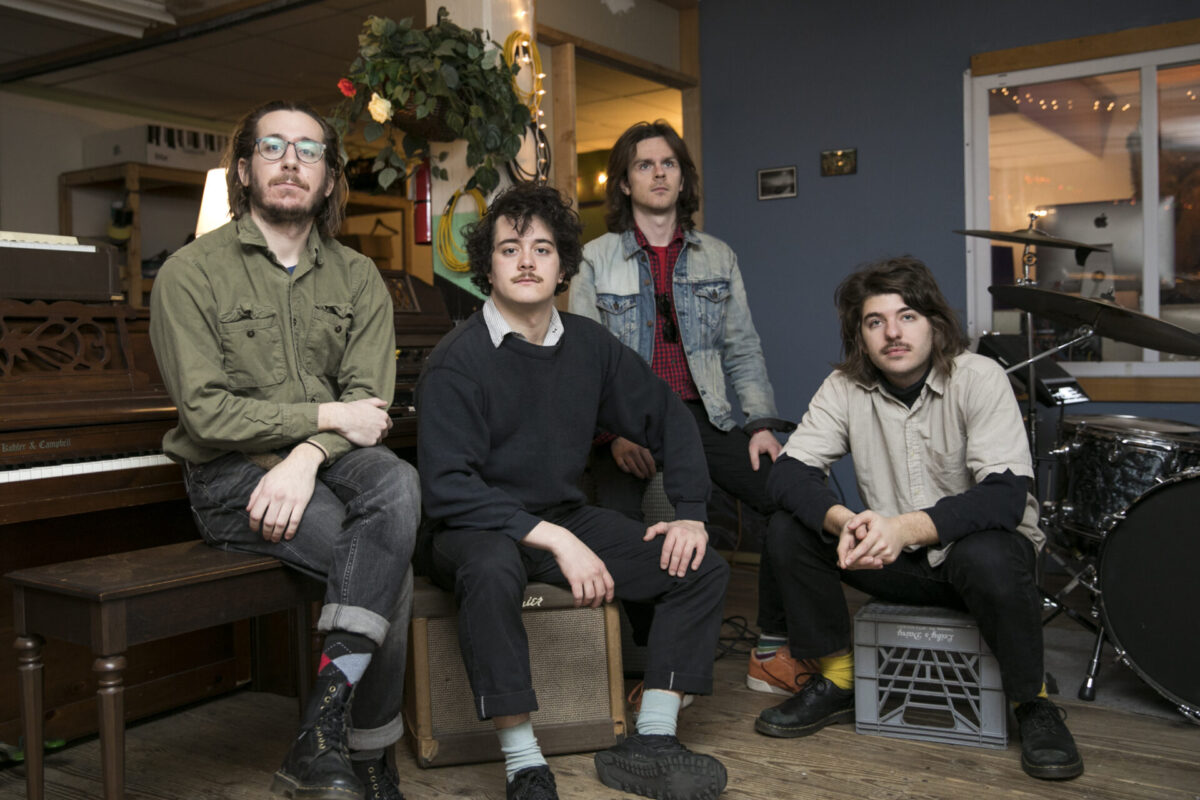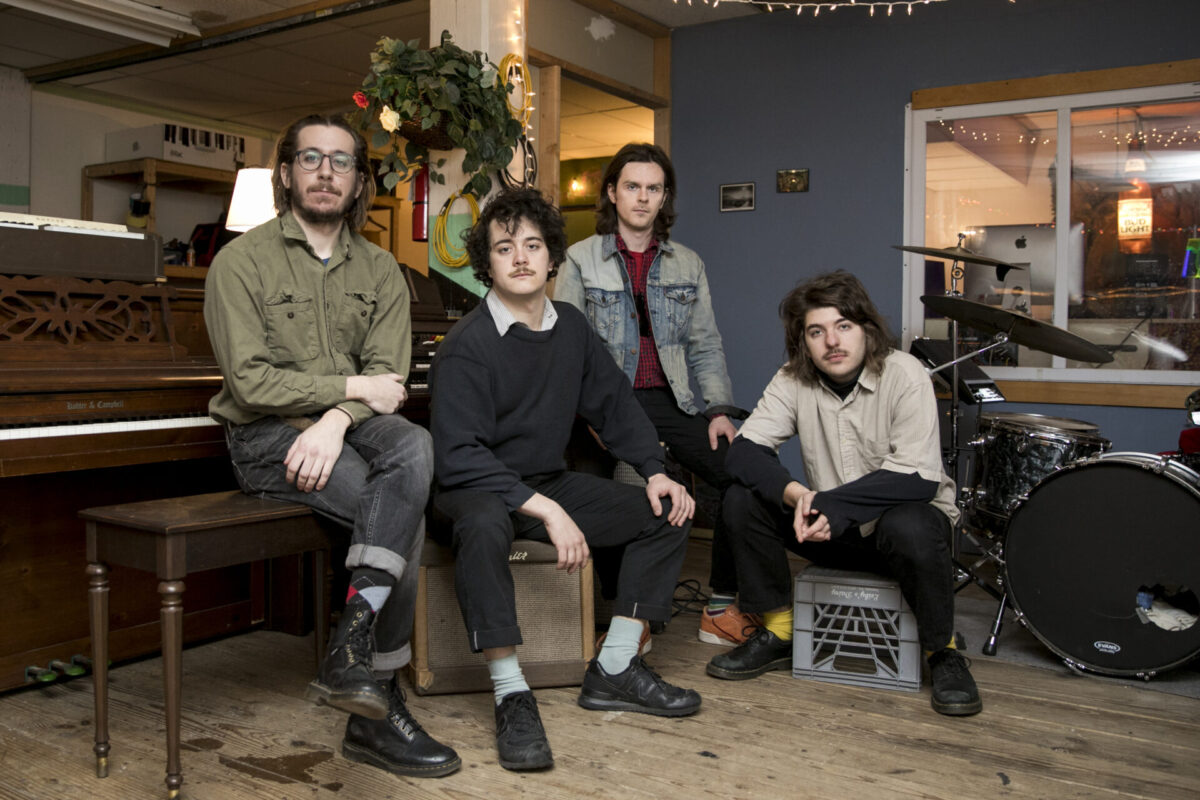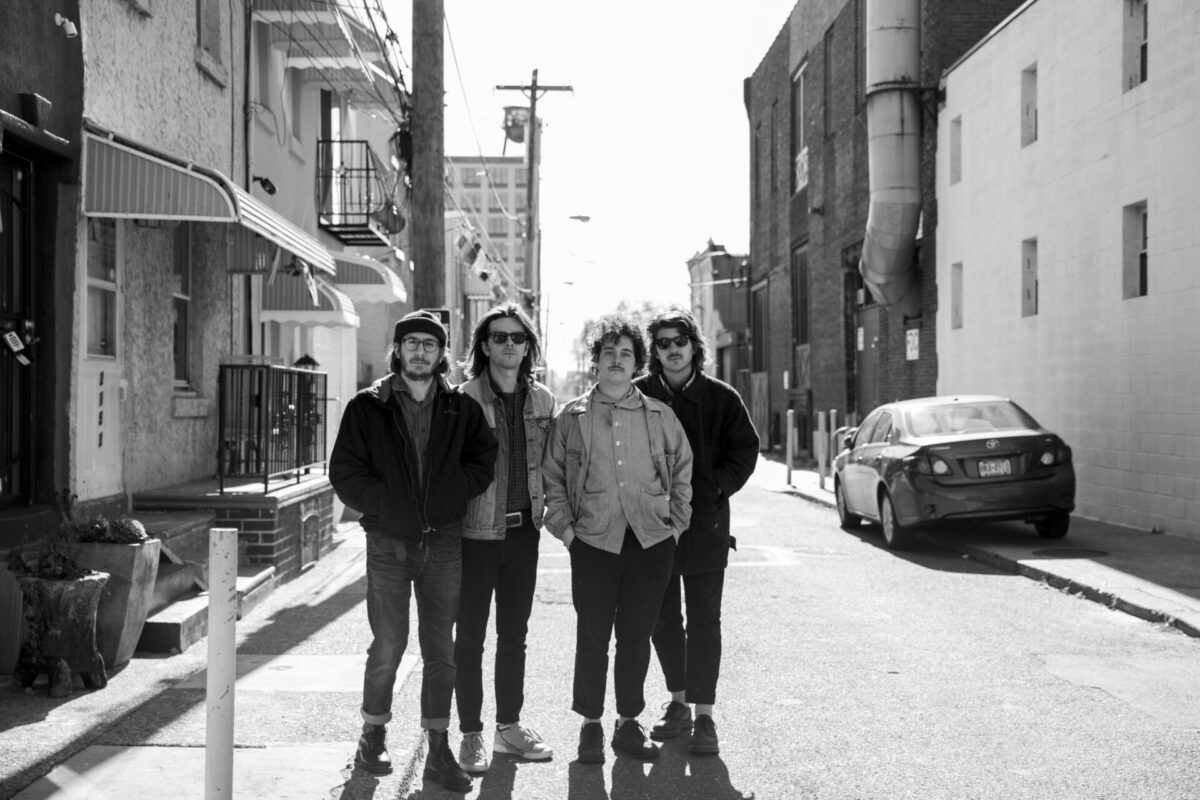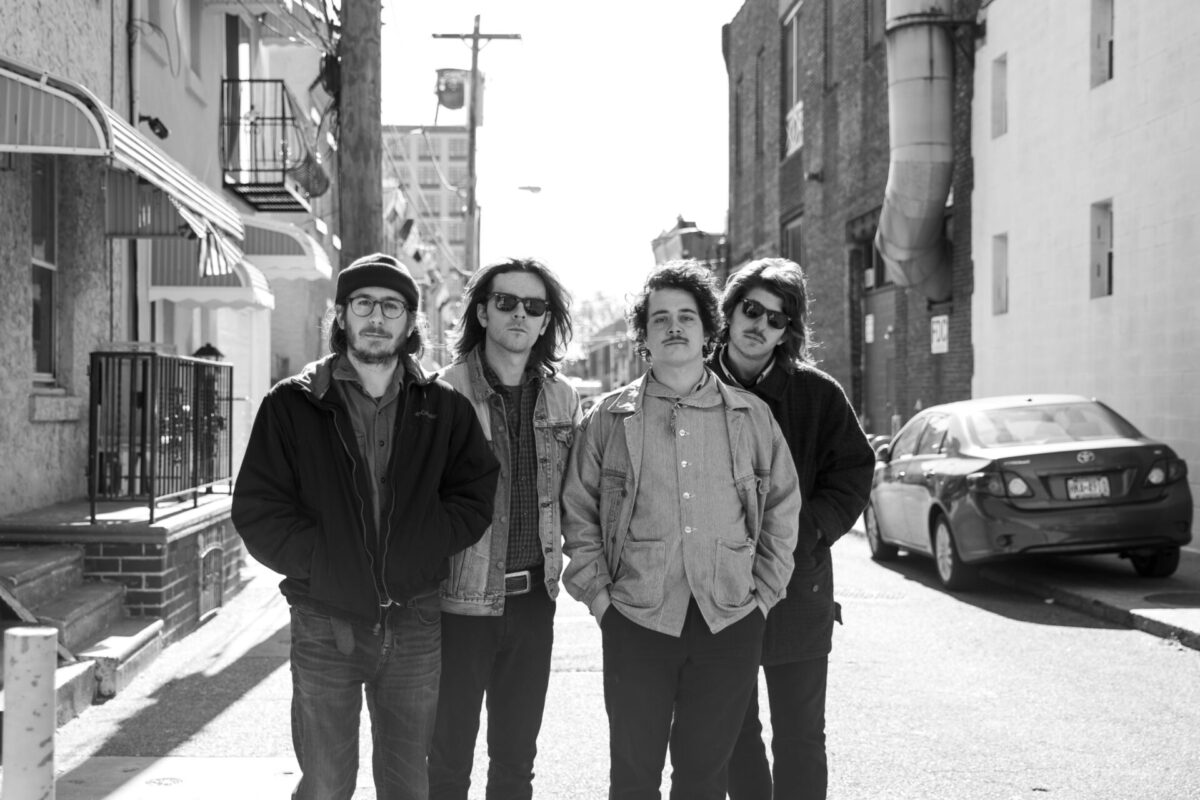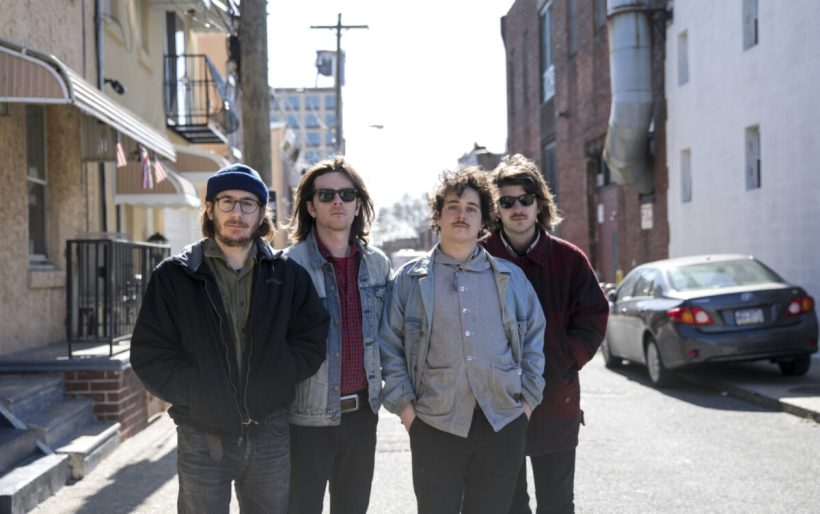
The Districts | photo by Rachel Del Sordo for WXPN
Sculpting the Movement: The Districts’ path from despair and escape to Not Going Anywhere
It’s a sunny Friday afternoon in February, and The Districts are outdoors with light jackets, posing for photos along Philip Street in Fishtown, not too far from their studio and practice space. It’s warm, the vibe is jovial and upbeat, but at the same time there’s a general uneasiness – a sense of malaise, impending doom. Sure, it’s beautiful out, but isn’t this supposed to be winter?
Contrast it to the same time last year, when the Philadelphia-based, Lititz-born band spent several weeks steeped in an actual winter climate. They holed up in a cabin in Hudson Valley, New York, surrounded by snow and large trees, musical instruments and a tape machine, pulling twelve-hour days to finish recording their new album.
Isolation in the woods provided a great space to focus The Districts’ creative energies, the band concurs, and getting outside their familiar surroundings and routine made You Know I’m Not Going Anywhere all the more impactful of an album. It’s a beautiful, lush set of songs about the desire to escape from frustrating times and also the realization that eventually, you have to find your way back to dry land. It’s The Districts’ most mature work – both in terms of songwriting potency and sonic ambition – and while the lyrical focus is on emotional and spiritual escape, it could not have been possible without escaping the band’s normal working routine.
We make our way into a warehouse basement covered in fresh paint with bright splashes of abstract accent color. Framed thrift store art adorns the walls, and a mélange of instruments surrounds the room. Drummer Braden Lawrence sits down at an upright piano to work some melodies out of his head, while guitarist Pat Cassidy and bassist Connor Jacobus show me the rest of the room, which they’ve occupied since late summer.
Production booths sit on either side of us; a chalkboard at the far wall runs down a recording project in between tripped-out cartoon sketchings. A giant plush white tiger sits atop a vintage all-in-one stereo that pops open to reveal a turntable, eight-track, radio, cassette deck and more. (“We need to find somebody who can fix this,” says Cassidy. “It literally plays everything.”)

The Districts tell me this spot is nicest they’ve occupied. The band shares it with their friend and collaborator Keith Abrams, who today is in his control room listening back to album mixes with the Philly band Buddie. Their previous practice space in Germantown was a musty room with a crumbling ceiling; it worked okay enough, though, as a space to hash out initial arrangements of the new songs that Grote presented to the band in demo form.
“’Velour and Velcro’ went through a few different versions,” Lawrence says of that work process. “The original demo was more how it is [on album], and then we tried a version that was more sludgy, or just slower. And then we took things from that demo to the final version, like the swelling crescendo. Every song has its own evolution.”
Grote sees a lot of possibility in The Districts’ new home. “Rather than just being in my room making a demo, trying to flesh it out… you can be recording and writing in a much more significant way,” he says. “Creating something that can actually last.”

A curious thing happened along the creative journey of The Districts, who debuted in 2012 with the self-released Telephone album – written and recorded when the bandmates were all around 16 years old. Between their label debut A Flourish and A Spoil in 2015, and its 2017 follow-up Popular Manipulations, the bandmates began dabbling in side projects and recording adventures that bounced between silly and surreal. Grote introduced an electronic pop persona called Goat Mumbles. Lawrence released songs as Haggert McTaggert, an on-and-off collab with Abrams. Grote notes that the first taste of the band breaking off in that way was Straw Hats, the punk-adjacent trio he, Lawrence, and their friend Breshon Martzall rocked in the late 20-teens. (Martzall full-on joined The Districts as a live keyboard player during their run with Twin Peaks in 2018.)
For the most part, the people who took note of these projects were either friends or ultra-fans, but they all had a significant impact on The Districts of 2020. “We started doing this stuff when we were pretty young,” reflects Grote. “There was a lot of pressure on The Districts. With Straw Hats, the biggest thing with that was – here’s a place where you can really just not give a fuck and just do whatever you want.”
Lawrence says he’s been using the Haggert McTaggert name for informal recording projects since high school, and it’s a constant way to sharpen his skills and learn new things.
“Before I put any solo music out, I had some confidence in drumming, but not in writing lyrics or playing other instruments,” he says. “So I definitely gained confidence, which is cool to bring to this.”

Grote concurs about his Goat Mumbles side venture psyching him up for the main event.
“You get back in touch with why you make music,” he says. “And then you’re fresh when you get back to this thing. Instead of thinking about expectations, you’re thinking about how good it feels to create freely, and then you can create more freely in this context.”
In the case of You Know I’m Not Going Anywhere, the record was created more freely than ever. Between the last album and this one, Grote has amassed a sizeable collection of keyboards and a copy of the recording software Logic for his laptop; the home demos that he presented the band with last winter were more fleshed-out than he’d ever brought them before – incorporating bass lines, drum rhythms, and in the case of “Dancer,” ideas for horn parts.
“In the past, I would bring an acoustic song and we’d all work on it,” he says. “This time, I was recording them more fully than normal. And at first I thought it meant that these couldn’t be Districts songs.”
But when the band heard his demos, they loved them and were game to figure out how to make these songs work for the whole ensemble. The dynamic “Dancer” is a perfect example of how a fully formed idea becomes an even more fully formed song: its experimental, nervy vibe is built around a driving polyrhythm and Fela-inspired horn leads that dip and dive. The bandmates strut around this structure soaked in space echo and a heady dub bassline. It’s one of The Districts’ most daring moments on the album (and to date), and almost all the elements were plotted out in Grote’s home demo.
“The first demo from the day I wrote it, I was singing the bass notes and the horn parts,” Grote says. “It was almost all written except the percussion, and just came together really naturally.”
Lawrence recorded the subtle-yet-emphatic beat one drum at a time, allowing him to be more dexterous with the snare rhythm jutting against the other pieces; Jacobus lent a moody, minimal staccato phrasing to the bass line; the band’s friend Chet Williams was enlisted to create the sax arrangements. The end result is something Grote likens to a “demented polka,” but that makes it sound more sinister / less beautiful than it actually is.

Letting go of the group writing process extended to the recording studio, as well. All of The Districts played multiple instruments throughout the album, and though Grote is still the primary writer-ly voice, his goal was to take the idea of “self” out of the album – for him as well as his companions. “I think it functions better when, instead of thinking about roles, you’re all creating something together,” he says. “
“You’re just focusing on making the song better,” adds Jacobus.
“Sometimes it doesn’t mean anything,” says Cassidy. “Or sometimes you need to play one note the whole time. It could be a million different things.”
And it goes back to those solo projects, too, learning and exploring on your own.
“It’s not about just being a guitar player or a bass player,” says Cassidy. “It’s nice to understand that more and more by making stuff on your own and coming back to this. Putting yourself aside is always the best way to do that and see the bigger picture.”
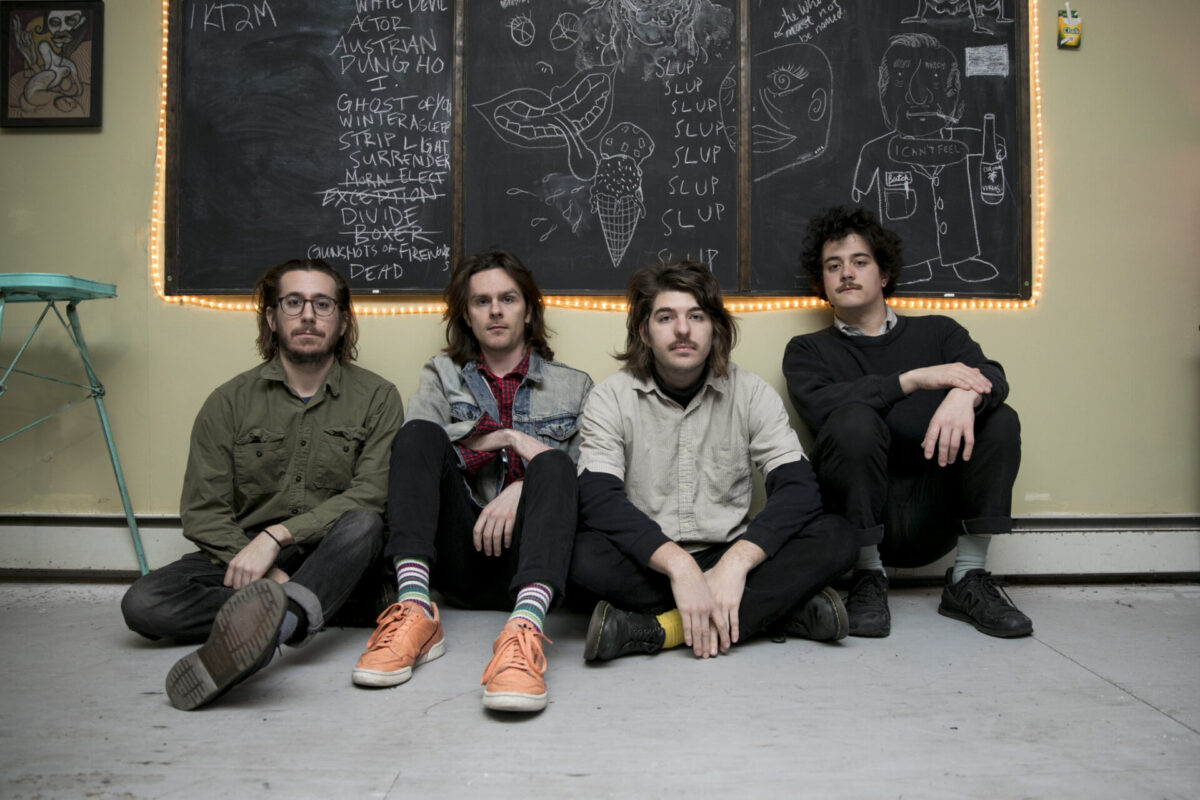
Grote and I duck down Frankford Avenue to grab a bite to eat at La Colombe, and on his own, he becomes more candid about the changes in The Districts’ creative process. “We’d done it one way for a while,” Grote says flatly. “And it was just feeling weird. We needed to figure out how to do this so it feels good.”
He points to the band’s last two albums – the raw Flourish recorded with noted indie rock producer John Congleton, an experience the band loved but acknowledged was a bit intimidating for four folks just out of high school, and the dreamier Manipulations balancing the load between Congleton and Abrams. Grote is proud of both records, and speaks fondly of working with Congleton, but says “I felt like something wasn’t happening that I needed to happen in my music. I felt like something was getting diluted for me. I wanted to get back to me purely expressing something.”
Hence taking the demos further than he ever had in the past. And then also the apprehension with doing that. “I was conscious of what that meant. Maybe a part is already written for an instrument. I was worried, am I going to hurt someone’s feelings? Am I stealing their input, or something? And I think what we eventually got to was something better: once we all looked at it as a thing where you can truly remove yourself from it, where we are a hive mind collectively creating something, then there’s no offense if someone is like ‘what if you do this instead?’ It’s not about taking stuff personally.”
Our conversation shifts from escaping from rigid processes to personal states – fear, frustration, and other feelings that permeate the lyrics on You Know I’m Not Going Anywhere. Grote finds that the constant preoccupations of his young life have been loss and longing; his parents divorced when he was four, and a lot of his young life was defined by the shuffle between homes. His grandmother, one of the people he was closest with in his childhood, passed away when he was in fourth grade. Even this album cycle found him writing songs while caring for an ailing dog, who eventually had to be put down.
Beyond an escape from sadness and frustration in his personal life, Grote finds himself profoundly affected by “the dissonance of the world, and the politics of everything going on.” The band was in Paris the night of the Bataclan shooting; they were playing a gig at its sister venue La Cigale. Though his response at the time was a numb shock and a quick phonecall to family to assure them he was safe, as time wore on, he found himself cripplingly upset every time he read about a school shooting.
“Somebody got to such a dark place that they decided to kill a bunch of people,” Grote says. “Why should kids have to be scared of that, too?”
He contrasts it with positives he’s experienced over the past few years: working with his bandmates to create the new record, falling in love…and doing so while perhaps not being in the best headspace to do so. Trying to make both sides of the spectrum coexist in his world.
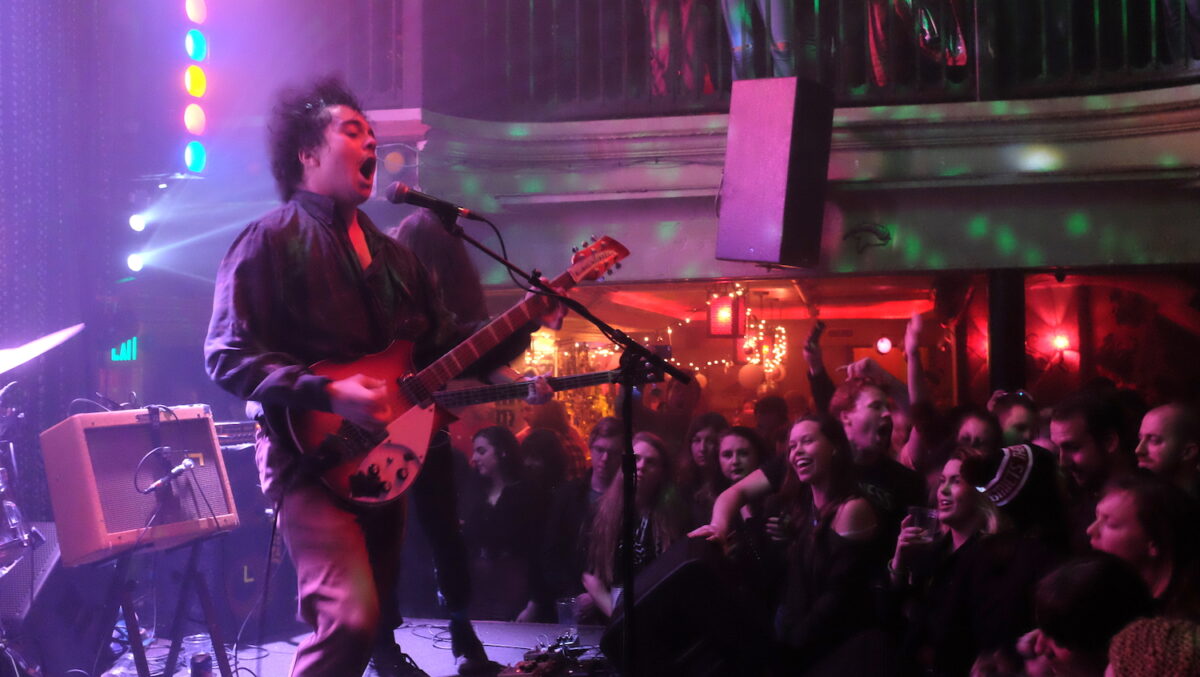
“When we play music, that’s also always been a place where I feel like I can let go and get out of my body in a way,” Grote says “And you can go to this place and experience these beautiful things, but at some point you have to come back and see reality. I’m making this song in my room, and it’s like ‘I want to share this with my beautiful bandmates, I want us all to go to this beautiful place cause we’re all dealing with these things.’ ‘I love this person and I don’t want to be detached and doing this. I want to come back down and be there.’”
He says going through that experience makes him realize why he makes music – to help people feel things, to help them think about things.
“Music to me has always been this place where you can get in touch with something that’s outside yourself,” Grote says. “It’s the only place in my life I’ve found spiritual comfort, through music. A lot of it is trying to both exemplify these feelings of longing, and also transcend them.”
That’s evident in the yearning rocker “Changing,” which Grote describes as “the first time I’ve ever sat down and wrote about my OCD.” The song reflects on the need for some kind of certainty in life, but simultaneously understanding you can’t have it. “So you’re always trying to escape this dissonance. That song is about how I can’t keep saying ‘it’s all because of these external factors,’ because they’re always going to keep doing that. At the end of the day it’s me. At the end of the day you come home to yourself. It’s easy to look for that transcendence through escape and that song to me is admitting you’re not going to find it there, you’re going to find it if you come home to what you have.”
The sweeping, atmospheric anthem “Velour and Velcro” plays on religious language and imagery, repeating the phrase “I believe in heaven, I have seen its truth” and placing it alongside the Christian mantra “Glory, glory hallelujah.” Grote sees it as a reflection on ideals of joy and happiness, something that we chase through life and seems always just out of reach. It’s about learning to live with the realization that your reality is your reality, for better or worse.
When I ask Grote if his family growing up was religious, he says “not particularly.” When he was very young, they’d go to church only on holidays, he says, while his father’s later interest Buddhism impacted his way of thinking into his adolescence and beyond (that studio idea of removing the self sounding particularly Buddhist). For a period of time, he and his father attended services by a dynamic Episcopal preacher in Harrisburg, and Grote was inspired by the way this person led services – shouting, falling to the ground, letting emotion coarse through him and by extension the congregation. “I was witnessing that transcendence and it was something I was really moved by,” Grote recalls.
But he remained despondent at that dissonance in the world. If you’d asked him a few years ago, he would have said he was atheist. These days, he sees his outlook as more spiritual in nature – recognizing the cosmic force of human consciousness and its untapped potential for collective good, while not tying those thoughts to any denomination or doctrine.
That idea of getting over yourself is given a somewhat aggressive, somewhat jovial take in “Cheap Regrets,” the driving, Joy Divison-esque dance song. Grote brims with excitement discussing the way it came together by chance during those cabin sessions. The band had workshopped a driving, dark electronic jam that Grote initially had only a great chorus for – a lyric about raising a statue over cheap regrets. “It’s the whole idea of this vain task,” Grote says. “You take all these useless regrets, you’re sculpting this magnificent thing out of them. Which to me is a nice metaphor for making music, period. It’s kind of this vain task in certain lights, but I also like it and think it’s great.”
Later, Grote found himself putting together an observational poem in his notebook about American culture and glamour. “And I thought, ‘I want speak these lyrics over a funky song.’ And it was like wait, we have a funky song, and it fits perfectly because it’s already talking about vanity.”
We turn to Tine Bek’s stunning cover art for You Know I’m Not Going Anywhere – the shimmering blue of ocean water, with the blurry form of a person beneath the surface. I note that it’s an image with both levity and gravity; it feels like a breezy snapshot of a beach vacation, but seen another way, is evocative of death, a body floating lifelessly beneath the surface of the water.
“It’s so vivid,” Grote says. “And it’s a positive-looking bright thing, in a way. I always picture it as this person taking a deep breath and floating underwater – which can be like whatever you do to escape things. What I like about the cover is at some point she’s going to come up for air, bit it’s a moment where she’s just floating, removed, and in this safe and beautiful comfort.”

Back at the studio, Grote and his companions are contemplating how uprooting their creative process had an unexpected positive effect: “It finally sounds like the band does live,” says Cassidy of a goal The Districts have worked towards with each record.
Grote sees it as adapting your process to your growth. “When you write a song, you hear all these little things in your head that you are trying to make happen, all these subtle accents and brushstrokes,” he reflects. “And maybe because of instrumentation, it can’t all happen live — but you’re all moving to it. Live you have your body to show it with, but in the recording you have to make that thing move, whether it’s a sound coming in here, whether it’s about a dynamic change. To me, it’s all about sculpting the movement.”
“In a lot of ways, making it felt like when we did Telephone,” add Lawrence. “We were experimenting and it was more like a recording project — and Flourish was bare bones live stuff, this was more of a recording project too.”
If you haven’t heard it in a few years (or ever), Telephone is an interesting, and rewarding listen; between the unique choices of trombone accents, cello backings, and field recordings intermixed with propulsive rock band jams, it’s fascinating to see how far The Districts have come since then, but also how great they were at the time – as a high school band.
“Looking back on that album, or each album we’ve done, it’s an interesting snapshot of our past,” says Jacobus. “Seeing the progression is always a fascinating thing.”
Grote says he feels far enough removed from Telephone that it feels like the work of a different person, but he’s also particularly proud of it – and sees a through-line between that album and the new one. It feels weirdly full circle, he says, the way that some of the stuff they were trying to do back then – the collage-y psychedelic elements, the left-of-center takes anthems — are now being done in a fully realized way.
“We were trying to make something that would make you feel something,” he says. “It’s kind of what we’re always doing, but that was us doing it as a young-wide eyed kids. We didn’t know what was going on in the world, we were in our bubble. And now we’re doing that having lived a lot.”
They’re gearing up to keep doing exactly that; their tour launched last week, and when we parted ways that Friday afternoon last month, the band spoke of how to use their time on the road more wisely than in the past. Running, juggling. Less drinking, more meditating. Fighting the van curse of sitting all day, looking out the window as the highway moves by.
“It seems daunting,” Cassidy says of tour. “And in a couple weeks into it, you’re in the middle of the desert, it’s like ‘oh, I feel like I never stop doing this.’ Which isn’t true, but when you’re in that world, deep into it, you’re in very familiar territory, and there’s something comforting about that. “
“On this record we’ve learned a lot,” Grote says. “We’ve changed a lot, we’ve grown up doing this shit. And looking back, we haven’t done everything right. But we haven’t failed. There’s something scrappy about that, we’re always clawing our way through.”
The Districts play Union Transfer with And The Kids and Sixteen Jackies on Thursday, March 12th. Tickets and more information can be found at the XPN Concert Calendar; for the band’s full tour dates, check their website.
